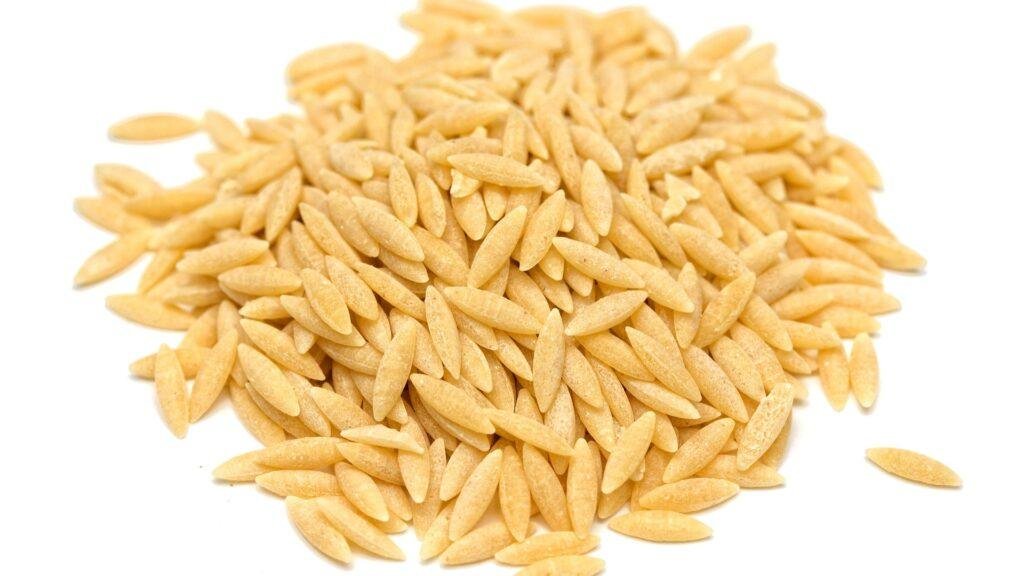Introduction to Orzo Pasta
Orzo pasta, a member of the pasta family, boasts a unique shape that resembles grains of rice, making it a popular choice in various culinary applications. This pasta hails from Italy, with its name derived from the Italian word for barley, “orzo,” reflecting its grain-like appearance. Traditionally, orzo is made from durum wheat semolina, though variations can include whole grain or gluten-free options. The texture of orzo is smooth, enabling it to absorb flavors well, which is one of the reasons it is frequently used in soups, salads, and baked dishes.
While orzo pasta might be mistaken for rice at first glance, its culinary versatility extends far beyond that superficial resemblance. Chefs and home cooks alike appreciate orzo for its ability to elevate a dish, whether served in a warm dish or as a chilled salad. Its quick cooking time makes it a practical option for busy weeknight meals, as it typically requires just 8 to 10 minutes of boiling. This makes orzo an appealing choice for various recipes, including risottos, pilafs, and even as a base for a variety of sauces.

Recent discussions have emerged around the potential benefits of using orzo pasta as a feed for racing pigeons, further expanding its relevance. As a carbohydrate-rich food source, orzo can play an integral role in the dietary regimen of these birds, potentially providing a reliable energy source for their intense racing activities. This introduction sets the stage for a deeper examination of the nutritional advantages of orzo pasta for racing pigeons and how this pasta might be aptly described as a new superfood in this context.
Nutritional Profile of Orzo Pasta
Orzo pasta, a small, rice-shaped type of pasta, has gained recognition not only as a staple in human diets but also as a nutritional powerhouse for racing pigeons. Understanding its nutritional profile is crucial for pigeon enthusiasts who seek to optimize their birds’ health and performance. Orzo pasta is primarily composed of carbohydrates, which serve as a vital energy source. This is particularly important for racing pigeons, as they require sufficient energy to sustain their long flights. A typical serving of orzo contains approximately 25 grams of carbohydrates, making it an excellent option for fueling their rigorous activities.
In addition to carbohydrates, orzo pasta contributes a moderate amount of protein, around 3-4 grams per serving. This protein content is essential for muscle repair and growth, especially after prolonged exertion during races. Racing pigeons benefit from the amino acids present in orzo, aiding in the recovery process and overall muscle development. Moreover, the fiber content, which averages about 1-2 grams per serving, promotes healthy digestion. A diet rich in fiber can help prevent digestive issues, thus maintaining optimal condition for racing pigeons.
The nutritional advantages of orzo pasta extend beyond macronutrients; it also contains an array of vitamins and minerals that are beneficial for avian health. Notably, orzo is a source of B vitamins, such as thiamine and niacin, which play roles in energy metabolism and overall health. Additionally, it provides essential minerals like iron and magnesium, contributing to various bodily functions, including oxygen transport and muscle function. Incorporating orzo pasta into the diet of racing pigeons can thus support their health, enhancing their performance capabilities and ensuring they are well-prepared for competition.
The Importance of Diet for Racing Pigeons

A balanced diet is essential for the overall well-being and performance of racing pigeons. Just as with any athlete, proper nutrition plays a crucial role in enhancing endurance, agility, and health. Racing pigeons rely on their physical condition to navigate distances effectively and return home swiftly, making their diet a significant factor in their training and racing outcomes. Historically, the feeding regimen of racing pigeons has included a variety of grains, seeds, and legumes, but new dietary supplements like orzo pasta are gaining attention as potential superfoods.
Orzo pasta, a small, rice-shaped pasta, is particularly appealing due to its rich carbohydrate content, which serves as a vital energy source for racing pigeons. The high glycemic index of orzo pasta provides quick energy, necessary for peak performance during races. Additionally, orzo pasta boasts a wealth of essential nutrients, including vitamins and minerals, which support the pigeons’ health and recovery. Integrating orzo pasta for racing pigeons may not only assist in meeting their energy requirements but could also potentially enhance their overall nutritional profile.
Moreover, traditional feeds have often been complemented with a mixture of seeds, corn, and pellets. While these staples contribute to the pigeons’ nutritional needs, the inclusion of newer options like orzo pasta can diversify their diet and introduce beneficial nutrients that traditional feeds may lack. The impact of dietary choices on racing performance is significant; a pigeon fueled by a balanced diet, inclusive of superfoods like orzo pasta, is likely to exhibit improved stamina and faster recovery times.
As more pigeon fanciers explore innovative dietary components, it is evident that a conscientious approach to feeding can yield notable advantages in racing outcomes. Choosing the right nutrition strategy is both an art and a science, ensuring that racing pigeons are equipped to perform at their best.
Comparing Orzo with Traditional Pigeon Feed
When evaluating the suitability of orzo pasta for racing pigeons, it is essential to compare its nutritional profile with that of traditional pigeon feed ingredients. Traditional pigeon feed typically consists of a mix of grains, peas, and seeds, which provide a balance of carbohydrates, protein, and essential fats. However, these conventional ingredients often lack specific nutrients needed for optimal performance in racing birds.
Orzo pasta, on the other hand, offers a unique array of benefits that can enhance the health and stamina of racing pigeons. It is a versatile grain that is rich in carbohydrates, which provide the energy required for racing. Orzo pasta also contains significant amounts of dietary fiber, essential amino acids, and micronutrients, including B vitamins and iron. The digestibility of orzo has been noted to be higher than that of many traditional grains, which could lead to improved nutrient absorption and overall health in racing pigeons.
One of the key advantages of incorporating orzo pasta into pigeon diets is its potential to minimize the risk of digestive issues. Traditional feeds can sometimes cause gastrointestinal discomfort due to their high levels of indigestible components. In contrast, orzo pasta’s structure is easier for racing pigeons to break down and process. However, it is important to note that while orzo provides numerous benefits, it should not completely replace traditional seeds and grains but rather complement them to create a well-rounded diet.
Potential drawbacks include the need to gradually introduce orzo to prevent digestive upset, coupled with the cost factor, as orzo pasta might not be as readily available as traditional feeds. In conclusion, orzo pasta presents a high-quality alternative that may offer significant advantages for racing pigeons, particularly concerning energy levels and nutrient absorption.
How to Incorporate Orzo Pasta into Pigeon Diets
Incorporating orzo pasta into the diets of racing pigeons can be a beneficial strategy, given its nutritional profile as a superfood. To ensure its effective integration, several practical steps can be followed. First, it’s important to prepare the orzo pasta correctly. Cooking the pasta until it reaches a tender consistency is essential, as this not only enhances its digestibility but also maintains its nutritional value. After cooking, allow the orzo to cool before serving it to the pigeons.
When it comes to portion sizes, moderation is key, as orzo pasta is rich in carbohydrates. A general guideline is to introduce orzo pasta as a supplementary food, comprising about 10-15% of the overall diet. This helps to prevent overloading on carbohydrates, which can lead to weight gain and associated health issues in racing pigeons. It is advisable to gradually introduce orzo pasta, starting with smaller quantities and observing how the birds adapt to it, before increasing the amount.
Combining orzo pasta with other feed types can enhance the diet’s overall balance. Pairing it with a mixture of seeds, grains, and legumes, or adding pellets designed for racing pigeons, can provide a more comprehensive nutrient profile and help meet the birds’ energy requirements. Additionally, incorporating vegetables like leafy greens can enhance the nutritional variety of the diet alongside the orzo pasta.
Lastly, always ensure that fresh water is available, as hydration is crucial for racing pigeons, especially when adding new foods like orzo pasta. Monitoring the pigeons’ health and performance after incorporating this superfood will provide insights into its effects, helping to optimize their diets for optimal racing performance.
Potential Benefits of Orzo Pasta for Racing Performance
Orzo pasta, often celebrated as a versatile ingredient in human diets, is now gaining attention in the pigeon racing community. This particular type of pasta, which is shaped like grains of rice, offers an array of potential benefits for racing pigeons, particularly in terms of enhancing their racing performance.
One of the foremost advantages of incorporating orzo pasta into a pigeon’s diet is its carbohydrate content. Racing pigeons require a considerable amount of energy during their races, and orzo pasta serves as an excellent energy source. The easily digestible carbohydrates present in orzo provide a quick fuel supply, enabling pigeons to sustain their energy levels during prolonged flights. Breeders who have integrated orzo pasta into their pigeons’ diets have reported noticeable improvements in endurance and speed, making this ingredient a valuable addition for competitive racing.
Moreover, orzo pasta is believed to support recovery times after races. The nutritional profile of orzo includes various essential vitamins and minerals that can aid in the repair of muscles and tissues after exertion. Pigeon owners often highlight the importance of a post-race recovery diet, and orzo can effectively contribute to this process, helping birds return to optimal condition more quickly.
Beyond energy and recovery, the overall health benefits of orzo pasta cannot be overlooked. This superfood is rich in antioxidants, which may help strengthen the immune system, ensuring that racing pigeons remain healthy and resilient against diseases. Trainers have noted that pigeons fed on diets incorporating orzo pasta exhibited fewer health issues and demonstrated improved vitality, contributing positively to their racing capabilities.
In conclusion, the potential benefits of orzo pasta for racing performance are manifold. From enhanced energy levels and improved recovery times to better overall health, this superfood can play a crucial role in maximizing the potential of racing pigeons.
Analyzing Recent Research and Studies
Recent scientific research highlighting the nutritional benefits of orzo pasta has garnered attention, particularly in the context of avian diets, such as those of racing pigeons. Various studies have concluded that orzo pasta acts as an advantageous carbohydrate source, which is crucial for the energy demands of racing pigeons. This is particularly important during their racing season, where endurance and speed are essential for optimal performance. The digestibility of orzo pasta also contributes to efficient nutrient uptake, further enhancing its reputability as a superfood.
Several experts in avian nutrition have conducted feeding trials to understand the effect of orzo pasta on racing pigeons’ performance metrics. One study published in a peer-reviewed ornithology journal reported significant improvements in flight times and overall health markers among pigeons fed a diet inclusive of orzo pasta. The trial indicated not just enhanced energy levels but also improved recovery times, showcasing the pasta’s role in quick replenishment of energy reserves following strenuous activities.
The rich profile of vitamins and minerals present in orzo pasta is another factor that has been researched. Content analysis reveals that orzo pasta is rich in B vitamins, which play a vital role in energy metabolism, as well as essential amino acids required for muscle repair and recovery. Moreover, the high fiber content aids digestion, ensuring that racing pigeons maintain optimal gut health, which is critical for peak athletic performance. This combination of benefits aligns with the definition of a superfood, suggesting that orzo pasta can provide racing pigeons with a well-rounded dietary component.
These findings collectively support the assertion that integrating orzo pasta into the diet of racing pigeons not only meets their nutritional needs but also enhances their competitive edge, positioning it as a valuable superfood in their dietary repertoire.
Expert Opinions and Testimonials
The introduction of orzo pasta as a potential superfood for racing pigeons has generated a range of opinions from experts in the fields of animal nutrition, pigeon racing, and veterinary medicine. Dr. Jennifer Lang, a leading animal nutritionist, emphasizes the nutritional benefits of orzo pasta, stating, “Orzo is a carbohydrate-rich food that can supply energy during intensive racing seasons. Its digestibility makes it a favorable option for maintaining optimal body condition in racing pigeons.” With its high carbohydrate content, orzo pasta is often compared to traditional grains, being an excellent source of energy needed for high-performance activities.
Many pigeon racers have shared their experiences regarding the incorporation of orzo into their feeding regimens. Tom Bentley, a seasoned racer with over two decades in the sport, mentions, “I started adding orzo pasta to my pigeons’ diet this season, and I’ve seen noticeable improvements in their stamina. They seem more energetic during training and appear to recover faster.” This anecdotal evidence supports the idea that orzo pasta may boost performance, aligning with the trend of seeking superfoods that enhance capabilities.
However, it’s important to approach this new feeding trend with caution. Veterinarian Dr. Sarah Gomez warns, “While orzo pasta can offer nutritional advantages, it should not replace a balanced diet that includes a variety of grains and seeds. Moderation is key. Regular veterinary assessments and dietary adjustments are essential to ensure the health and well-being of racing pigeons.” This message reinforces the need for comprehensive diets that incorporate various food sources, including orzo pasta for racing pigeons, while monitoring their overall nutrition.
In conclusion, the perspectives gathered from experts indicate both excitement and necessary caution regarding the role of orzo pasta in the diets of racing pigeons. As with any dietary addition, consulting with professionals and ensuring a well-rounded feeding strategy remains critical for optimal performance and health.
Conclusion: Is Orzo Pasta the Future Superfood for Racing Pigeons?
In evaluating the potential of orzo pasta as a superfood for racing pigeons, it is essential to consider both the benefits and drawbacks associated with its integration into their diet. This unique grain, rich in carbohydrates and nutrients, offers an energy-dense option that can support racing performance. Its high digestibility can also be beneficial for maintaining optimal body condition, especially during intense training and competitive events.
Orzo pasta boasts an attractive nutritional profile with vitamins, minerals, and essential amino acids that contribute to the overall health of racing pigeons. The inclusion of orzo pasta in their diet could significantly enhance their endurance and recovery capabilities, making it a practical choice for seasoned racers aiming to improve their competitive edge. Additionally, the versatility of orzo allows it to be easily incorporated into various feeding regimes, whether mixed with grains or served alone.
However, it is crucial to address potential concerns surrounding the introduction of orzo pasta into a racing pigeon’s diet. While the grain is beneficial, over-reliance on any single food source can lead to nutritional imbalances. Ensuring a well-rounded diet that includes other grains, seeds, and supplements is paramount to maintaining optimal health. Furthermore, each bird’s unique dietary requirements must be considered; what may work for one pigeon might not yield the same results for another.
In conclusion, while orzo pasta presents a compelling case as a superfood for racing pigeons, it is advisable for caretakers to conduct thorough research and possibly consult a veterinarian or avian nutritionist. This ensures that the introduction of orzo pasta complements existing feeding practices and aligns with the specific needs of each individual bird. By carefully evaluating its potential alongside traditional diet staples, racing pigeon enthusiasts can make informed decisions that support the health and performance of their avian athletes.

